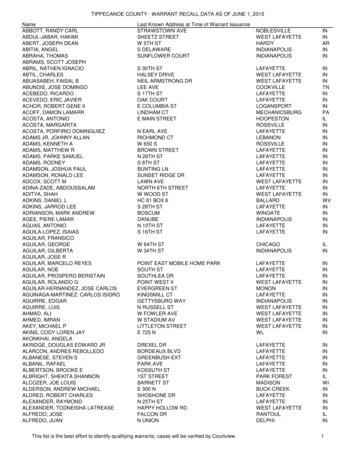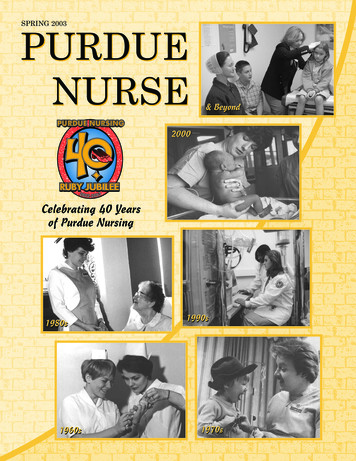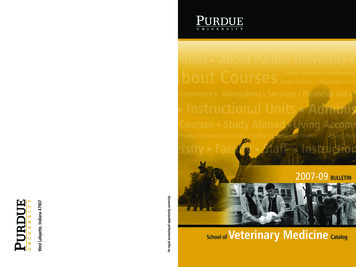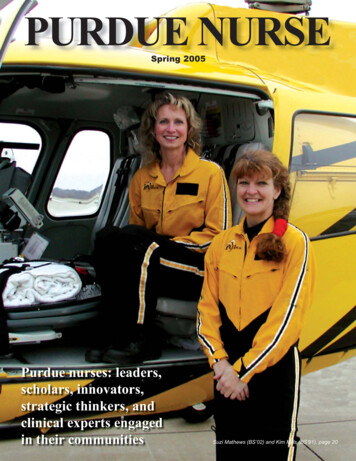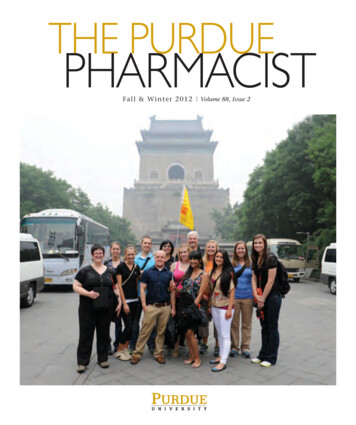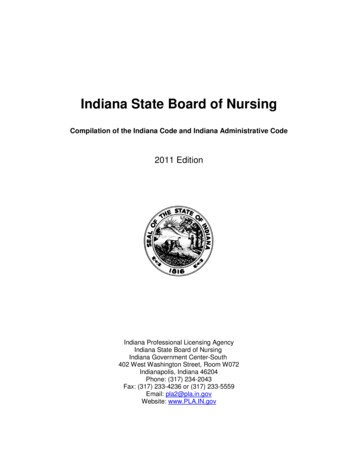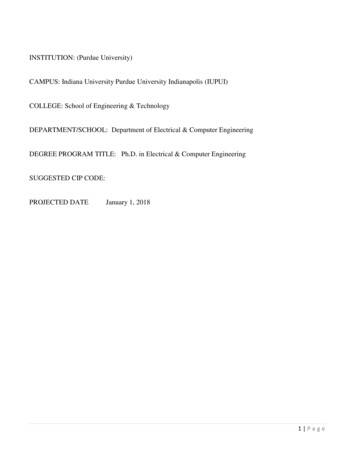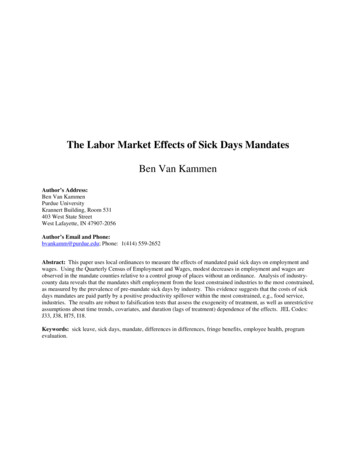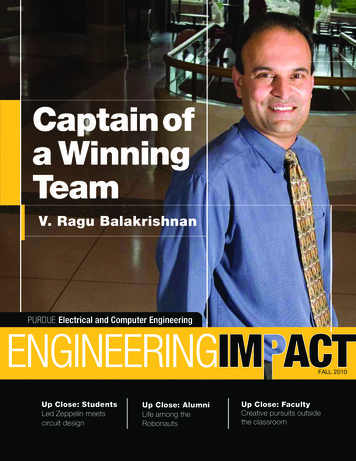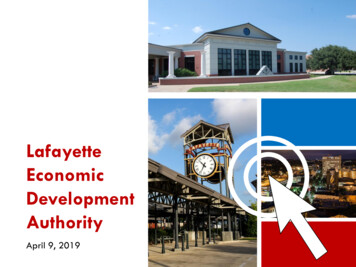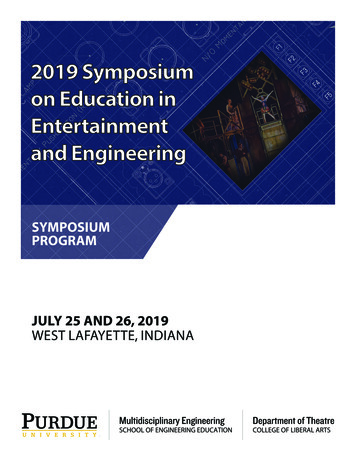
Transcription
SYMPOSIUMPROGRAMJULY 25 AND 26, 2019WEST LAFAYETTE, INDIANA
July 25-26, 2019Welcome to the Inaugural Symposium onEducation in Entertainment and Engineering!Do I contradict myself? Very well then I contradict myself, (I am large, I contain multitudes.) These lines, fromWalt Whitman’s Song of Myself, have echoed in my head throughout my career. Our world sometimes wants to define eachof us within narrow categories (“engineer,” “theatre technician,” “educator”); just recently, I was encouraged in a professionalmentoring meeting to start thinking about choosing which of my interests in stortytelling, technology on stage, technicaldesign, or instructional design I would start focusing on as my specialization. That’s an impossible choice in my mind: eachof these areas of research and interest inform and are enriched by the others, and my practice would be lessened by makingsuch a choice.I am fortunate to have a like-minded partner and colleague in Mary Pilotte, with whom I’ve been able to craft an educationaljourney for students that is intentionally silo-breaking, embracing the multitudes our students contain. In the past fiveyears, I’ve been blessed to meet students who love stories and machines; who are passionate about amusement parks andthe fantastic worlds they allow us to explore; who are fascinated with control systems and the animatronic characters theybring to life. Their interests combine multiple domains, and challenge us to find ways to make those combinations possible.My hope for this Symposium is that it provides opportunities to build connections among other like-minded mold-breakers,whose journeys and passions have taken—and continue to take—them across traditional disciplinary boundaries. Thanks toall of you for sharing your time, your energy, and your passions with us.Rich DionneAdventurous interdisciplinarity and collaborative/engaging pedagogies of instruction are values that reside at theheart of the domain of Engineering Education (ENE). So nearly 5 years ago, when I became Director of ENE’s undergraduateprograms for interdisciplinary engineering studies and multidisciplinary engineering and was introduced to like-minded soulProfessor Rich Dionne from the Theatre department, it was like “coming home” to a warm familiar place. Little did we knowthat our first meeting would be laying the groundwork for the grand collaboration we are sharing in today.At the time we met, we had a few undergraduate engineering students “dabbling” in the arts, their pathways each handcarved, and one of a kind. Fast forward to today, where we now have two established Theatre Engineering plans of study, wehave nearly 20 students either in the pipeline or graduated from these plans, we have co-hosted our first USITT RegionalMachine Design Competition, and now stand before you in a formal symposium, one that was born out of a “crazy idea” oneday in Chicago.While each time compressed and residing in our respective disciplinary silos, time spent on these collaborative efforts havemultiplied opportunities for our respective programs and students many times over, beside paying personal dividends fromjoyful collaboration. Our work together has not only been a pleasure, it has resonated for many students who until now,probably made difficult career choices; the kind that swap stability for passion, and challenge the idea that you can actuallybe all engineer, and all in for the arts as well.For all that we have accomplished together, we are just getting started. There are so many more “crazy ideas” we hope to bringto life. We most sincerely thank you for sharing your talents and being willing to join in our creative sandbox. We also hopeyou will be inspired by the many talents and perspectives that are shared today—in the same way our mutual students haveinspired both Rich and myself.Mary Pilottepage 1
Symposium on Education in Entertainment and EngineeringSymposium Co-HostsRich DionnePurdue UniversityMary K. PilottePurdue UniversityRich Dionne is a clinical assistantprofessor and faculty technicaldirector in the Department ofTheatre in the Patti and RustyRueff School of Design, Art, andPerformance at Purdue University.Hespecializesinsceneryautomation and show control systems while alsoserving as the department’s production manager. Hehas a passion for both the art of theatre and the scienceand engineering of making theatre happen. Rich is afounding Faculty Fellow of the Purdue PolytechnicInstitute, and has served as the technical director fornumerous productions in the Department of Theatre.He teaches courses in structural and mechanical designfor the stage, automation controls and show networks,project planning and advanced arena rigging tostudents in theatre and theatre engineering.Dr. Mary Pilotte is an AssociateProfessor of Engineering Practiceand is also Director of the SchoolofEngineeringEducation’sUndergraduate degree programsin Interdisciplinary EngineeringStudies and MultidisciplinaryPrior to coming to Purdue, Rich was the productionmanager and resident sound designer at TheShakespeare Theatre of New Jersey, where he mountednumerous productions at various indoor and outdoorvenues, including a nationally-recognized educationaltouring company. Additionally, he has served as thetechnical director for Berkshire Theatre Festival, AlpineTheatre Project, Weston Playhouse Theatre Company,and Dorset Theatre Festival, mounting criticallyacclaimed productions including The Whipping Man,Barefoot in the Park, Amadeus, Night of the Iguana,Avenue Q, The Illusion, and Death of a Salesman. Rich’sbook, Project Planning for the Stage: Tools and Techniquesfor Managing Extraordinary Performances, focusedon the application of project planning techniquesfor theatrical production, was recently published bySouthern Illinois University Press. The eighth editionof Theatrical Design and Production, for which he is a coauthor with Michael Gillette, was recently publishedby McGraw-Hill.page 2Engineering.She teaches varied topics across levels of studentdevelopment, from professional development toengineering economics and Senior Capstone Design.Outside of the College of Engineering she instructsproject management and consulting approachesfor the Global and Executive MBA programs at theKrannert School of Management at Purdue, and headscorporate work- shops based on her book “MillennialReset” (2018) and on Intentional Learning.Her research interests include engineering workculture including generations-based engineeringpractices and norms, examining what it means toidentify as “multidisciplinary”, and exploring newapproaches and dynamic strategies around increasingworkplace diversity, especially for the neurodiverse,and those with invisible differences.Prior to her roles in the academic setting, she workedprofessionally for more than 20 years in the automotive,aerospace, airline, and commercial products industries,holding a variety of titles. She lead high performingteams in manufacturing, design-engineering for newproduct and process development, and ultimately inplant management and finance completing strategicmergers and acquisitions.
July 25-26, 2019Symposium ScheduleThursday, July 25, 20196:30 PM7:00 PMEarly Registration OpensWelcome Reception and Plenary Remarks with Dionne/PilotteArmstrong AtriumArmstrong AtriumFriday, July 26, 20197:30 AMRegistration OpensStewart Center8:30 AMPerformance as PedagogyTeaching Rhetoric to Engineers with Shakespeare, John C. TomkinsUnderstanding the Nuremberg Trials: An Examination of the Use ofLive Theatre as an Educational Tool, Amanda MayesExploring Diversity Issues Through Robot Theater, Denise SzecseiStewart Center9:45 AMMorning Panel SessionEngineering and Entertainment: An Academic PerspectiveMary Pilotte (moderator), Mark Budnik, Dan Lisowski, AnnShanahanStewart Center11:00 AM Beauty in Engineering and the Performing ArtsBeauty in Engineering and the Performing Arts, Catherine Skokan,et. al.Stewart Center12:00 PM LunchStewart Center1:00 PMRobot Theatre PerformanceMallett Theatre2:00 PMAfternoon Panel SessionEngineering and Entertainment: An Industry PerspectiveRich Dionne (moderator), Alvah Aldric, Matt Jackson, BethMartell, Kimberly Corbett OatesStewart Center3:15 PMExperiential Learning and Tool BuildingInternational Competition as Stopgap Curriculum, KatherineWoodcockAcoustic Engineering Workstation, Geoffrey Akers, Nic WhiteStewart Center4:30 PMEngineering ArtUndergraduate Capstone Project: A Graphic Rain System, KatherineMetzlerPhotonics for Historical and Modern Visual Arts, AlexandraBoltassevaStewart Center6:00 PMDinner and Plenary Remarks with Dionne/Pilottepage 3
Symposium on Education in Entertainment and EngineeringPresentation Abstractsin alphabetical order by the lead presenter’s last nameAcoustic Engineering WorkstationGeoffrey Akers, College of the OzarksThe College of the Ozarks is developing the ability tooffer acoustic engineering services to on and off-campus customers. The College is the only federally-recognized work college with an engineering program.Students do not pay tuition and are assigned workstations on campus to help defray expenses and togenerate income for the College. The engineeringprogram began in 2016, and the Engineering Servicesworkstation began in 2018 with one engineering student supervised by an engineering faculty member.The workstation has two primary objectives. The firstis to provide a learning environment for engineeringstudent workers, which includes field experience inthe engineering design process, project management,customer interaction, and mentorship by faculty,industry partners, and local engineers. The second isto provide services to campus and off-campus customers. This paper addresses the purpose and administration of the workstation, the perceived benefit tothe student workers and the engineering program, aswell as the recent work station accomplishments. Ata minimum, the accomplishments will include designing, fabricating, testing, and analyzing acoustic panelsfor a small sound studio, as well as measurements ofthe small studio before and after the acoustic treatments.3:15 pm, Stewart CenterPhotonics for Historical and Modern Visual ArtsAlexandra Boltasseva, Purdue UniversityThe impact of photonic technologies on our societycannot be overestimated; by controlling light,photonics is finding a home in art and design.Microscopy, spectroscopy, hyperspectral imagingand interferometry are tools for unlocking details incenturies-old paintings and enable old paintings andfrescos to be preserved. A recent study has investigatedhow optics was used to create art centuries ago,unlocking the secrets of renowned artists, such asBellini and Caravaggio, who appear to have used opticalprojections to guide the proportions in the scene.Lasers have been work horses on performance stagespage 4and in museums allowing artists to do new things byenabling fascinating animation, graphics and magical,“alive” museum portraits.Recent developments in ultra-thin, flat optics enabledby metamaterials and metasurfaces has expandedthe realm of lenses and holograms include extremelythin meta-coatings instead of bulky, volumetriccomponents. These new metasurfaces bringsignificant advancements into hologram technologywith potential impact on visual arts via ultra-compact,easy-to-make, robust and full-colored holograms. Newconcepts for light manipulation with metamaterials,metasurfaces and photonic crystals could furtherenhance artists’ capabilities.This cross-disciplinary talk will give an overviewof optical approaches for historical and visual artsinvolving a wide range of optical designs and materialsthat merge engineering and arts, such as ceramics,colored glasses (such as those hosted by the CorningMuseum of Glass), optical fibers for entertainmentand fashion textiles, and more.4:30 pm, Stewart CenterUnderstanding the Nuremberg Trials: AnExamination of the Use of Live Theatre as anEducational ToolAmanda Mayes, Purdue UniversityDoes experiencing a live theatrical performance helpcollege students contextualize academic content?What benefits do students gain from the performanceoutside of the stereotypical textbook readings andclass discussions? Survey research conducted at PurdueUniversity indicates exposure to live performancesoffers significant benefits for college students intheir ability to understand and critically analyze thehistorical events they learn within their coursework.Our research indicates that live theatre could assistin enhancing traditional education models at thecollegiate level and should be explored further as apotential methodology to aid in student success.8:30 am, Stewart Center
July 25-26, 2019Undergraduate Capstone Project:A Graphic Rain SystemKatherine MetzlerA graphic rain system displays visual shapes in thepatterns of rain droplets as they fall. Any such systemmust be closed loop, recycling water with little lossover time and incorporate a self-contained reservoir.Ideally, such a system must be able to display multiple,recognizable shapes as the water droplets fall, andbe operated by a user with minimal training. And,of course, all elements of the system must adhere torelevant and appropriate safety codes.Mechanical engineering students at University atBuffalo-SUNY enroll in a capstone design course intheir senior year. Typically, students in this courseform small groups and are assigned a challenge by theinstructor; during the course of the semester, studentsprogress through a design process to generate aprototype solution to the challenge they’ve beengiven. In some instances, students can bring a specificdesign challenge that matches their career goals andpassions, and are permitted to design a solution tothat challenge instead.As part of her capstone project, Metzler undertook tocreate a small scale version of a graphic rain system.During this presentation, Metzler will share thedetails of the specific design challenge as well as thesolution she has pursued in achieving the design goal.Additionally, Metzler will discuss how this capstoneproject has allowed her to merge her twin passions ofart and engineering. Further, she will examine how thisproject has provided her with an opportunity to exploreboth artistic expression and deeper understanding oftechnological and engineering principles.4:30 pm, Stewart CenterBeauty in Engineering and the Performing ArtsCatherine Skokan, Jonathan Cullison, John Persichetti, Robert Klimek, Colorado School of MinesThis panel presentation will be led by two engineeringfaculty and two Music and the Performing Artsprofessors, all of whom work closely in collaborationat Colorado School of Mines (CSM). The presentationwill be a combination of discussion, demonstrationand ‘hands on’ challenges.The engineering design process has been representedin many ways but can generally be distilled into aniteration of elements that include design, construction,evaluation, and cycling back through redesign until apolished final product is achieved. Music compositionand performance use this same process. Likewise,any theatrical production follows a similar envisionedapproach that, with the keen eye of a director, is subjectto iterative manipulation of staging, blocking andlighting/sound effects, all to fit within the constraintsof a particular stage, abilities of those involved, andbudget. And, we cannot disregard the same step-bystep process in the visual arts.History has shown us that many masters of creativegenius were both “engineer” and “artist” – those whogave us the engineering marvels of the EgyptianPyramids, the beauty of Michael Angelo’s SistineChapel , DaVinci’s paintings and the many designersof musical instruments and performance spaces. Whyis it then that these creative endeavors are often seenas being at opposite ends of the educational spectrum?Also, should engineers be taught to see themselves as‘artists?’11:00 am, Stewart CenterExploring Diversity Issues Through Robot TheaterDenise Szecsei, Univeristy of IowaThe University of Iowa’s Robot Theater Projectpromotes STEM education and outreach activitiesprimarily using two commercially available robots:NAO humanoid robots, available through SoftBankRobotics, and Cozmo, developed by Anki. Studentsinvolved in this project write scripts and programrobots to perform theatrical skits on stage in front oflive audiences.In this paper we introduce our Robot Theater Project,describe the framework used to coordinate the behaviorof multiple robots in a scene, discuss the challengeswith live performances involving robot actors,present the difficulties in using robots from differentmanufacturers, and share results from our most recentinitiative: working with students to develop a series ofshort skits that focus on exploring human experiencesand behavior using robots as actors, where the contentof these performances centers on material related todiversity and representation.8:30 am, Stewart CenterTeaching Rhetoric to Engineers with ShakespeareJohn C. Tompkins, Purdue UniversityThis paper presents the use of Shakespeare in thesyllabus of a large-format communications classdesigned for civil engineers. It gives an overview of thepage 5
Symposium on Education in Entertainment and Engineeringcourse, including the philosophy behind its creationand the particulars of its population. Shakespeare’spresence in the course is justified on two grounds: first,that rudimentary acting practice significantly reducesself-consciousness in public speakers and second,that Shakespeare’s speeches exemplify classicalrhetoric, and are thus grounds for both the practiceof persuasion and the study of its parts. The AmericanShakespeare Centre has used a similar pedagogy tolaunch its Leadership Programming initiative, whichoffers communication training to executives andofficials through the medium of great speeches fromthe plays. A sample assignment, rubrics, and a syllabusare provided.8:30 am, Stewart CenterInternational competition as stopgap curriculumKathryn Woodcock, Ryerson UniversityStudents aspiring to careers in the themedentertainment and attractions industry have fewformal options to learn and demonstrate skillsand knowledge specific to the industry. Studentshave shown initiative in developing extracurricularactivities, and industry has reached out to offer “nextgeneration” programs and internships. It still remainsproblematic for industry employers to select the bestqualified students from a large pool of aspirants and formotivated candidates to stand out as highly qualifiedfor these opportunities. The Ryerson Invitational ThrillDesign Competition (RITDC) was developed to addressthis problem. RITDC provides learning experiencesand performance evaluation with not only completionas an indicator of accomplishment, but concurrentinteractive evaluation by judges from industry. As such,although the competition is formally an extracurricularactivity, it functions as stopgap curriculum.RITDC has grown exponentially with the support ofindustry sponsors. Through participation growth andscope expansion, the competition maintained a focuson specific entry-level professional skills in a uniqueindustry by adopting an interdisciplinary structure.Realistic, focused challenges showcase real skillexpectations for entry level professionals and interns,not just technical skills and knowledge but alsointerdisciplinary collaboration, time management,creative agility, and presentation. Judges fromUniversal Creative and its partner companies take anavid interest in how teams adjust to time pressures,approach problem definition, make trade-offs, andpresent their proposals. Competition alumni havepage 6taken internships and graduate employment in theattractions industry.The competition continues to adapt and learn fromyear to year as it encounters various challenges, rangingfrom participant disclosures and media, logisticsof academic absence and institutional oversight,challenges for teams to cover their costs, barriers tointernship opportunities, and growing workload forproduction and direction of the competition. Throughthis evolution, the partners remain committedto sustaining and exploring the potential of thecompetition, whether it remains “stopgap curriculum”or transitions to formal curriculum.4:30 pm, Stewart Center
July 25-26, 2019Panel DiscussionsMorning Panel — Engineering and Entertainment: An Academic Perspective“In the longer run and for wide-reaching issues, more creative solutions tend to come from imaginative interdisciplinarycollaboration.” Robert Shiller, Contemporary Economist, Author and Nobel LaureateIn spite of many outside and within higher-education believing in the spirit of this quote, fostering, supporting,and sustaining such vital interdisciplinary collaboration, especially across domains of practice, can be challengingat best. Constraints revolving around curricular control and oversight, limited financial and human resources,lack of shared metrics/incentive systems, and more abound. Yet, for those who endeavor to engage in effortsand programming such as that found within Entertainment/Theatre Engineering, the nascent opportunity andpersonal rewards appear to far outweigh the real or perceived obstacles.This panel, which will include faculty and administrators from a range of universities, hopes to begin to unpacka range of critical items related to nurturing the interdisciplinary nature of Entertainment/Theatre Engineering,including: Barriers to integrating entertainment and engineering programs, and suggestions for overcomingthem. Fostering the fire for interdisciplinary education innovation and scholarly work. Promoting and sharing excellence and best-practice stories in Entertainment Engineering. The value of industry voice in promoting creative interdisciplinary programs. Exploring the ways engineering-based pedagogies can inform liberal arts education and what artseducation can give to engineering students.Moderated by Dr. Mary Pilotte, this discussion is designed to bring value to all symposium attendees passionateabout the growth of this new and exciting interdisciplinary field. Ample time will be set aside to ensure discussionand question/answer is allowed to flourish.Afternoon Panel — Engineering and Entertainment: An Industry PerspectiveAs audiences have demanded increasingly spectacular and immersive experiences, the live entertainmentindustry has expanded to mean more than traditional plays and musicals on regional stages. “Live entertainment”encompasses regional and commercial theatre, to be sure, but has come to include everything from cruise shipperformances to concert tours, circus acts to themed amusements, and anything in between. This expansionof the definition of “live entertainment” has occured concurrent with an increasing expectation in the level ofcomplexity of the visual and aural landscapes that surround these events. From giant, moving stages, to compleximmersive rides, from rapidly-moving lighting fixtures to large integrated networks delivering video content,meeting these challenges has required a greater reliance on engineering expertise.This panel will include representatives from a variety of aspects of the entertainment industry, includingproduct development, design implementation, and architectural consulting, and will attempt to discuss theplace of engineering in the industry, examine existing trends in technological advancement, and explore futurepossibilities in the development of technologies for live entertainment.Moderated by Professor Rich Dionne, this discussion intends to bring value to attendees who are passionateabout current and future applications of engineering practices, techniques, and knowledge to the evolution of liveentertainment. Ample time will be set aside to ensure discussion and questions from attendees.page 7
Symposium on Education in Entertainment and EngineeringSpecial Presentation: Robot Theatre1:00 pm, Mallett Theatre, Pao HallThe University of Iowa’s Robot Theater Project(UIRTP) began with the goal of incorporatingrobot technology into the performing arts asan innovative way to promote STEM educationto underrepresented students. We offer RobotTheater First-Year Seminars, use robots indemonstrations and outreach activities, offerworkshops to K12 students, and invite the public toattend live performances that showcase students’creative works. We are now moving towards theexploration of how robots can be integrated intomore mainstream theatrical performances as wellas the consequences of that integration.Inspired by the popularity of dance-offcompetitions like So You Think You Can Dance and Dancing With The Stars, teams of Cozmo robots willchallenge each other to a dance street battle, with NAO robots serving as the MC and the official judges.Opinions of volunteer human judges will be encouraged.Presenter Biographiesin alphabetical orderGeoffrey Akers, College of the OHzarksDr. Geoff Akers is an Associate Professor of Engineeringin the James P. Keeter School of Engineering at theCollege of the Ozarks, the only engineering programat a federally-recognized work college. Dr. Akers hada distinguished 20-year career in the US Air Force,retiring in 2016 as a Lieutenant Colonel. The majority ofLt Col Akers’ career focused on developing and testingstate-of-the-art aerospace systems. Geoff now assistsin development of a multidisciplinary engineeringprogram that provides essential engineering skillsanchored with the Christian worldview to meet theneeds of employers in the Ozarks and beyond. Inaddition to teaching at the College, he has initiated astudent work station to provide acoustics engineeringconsulting service to campus customers, and eventuallyoff-campus customers, as well.Alvah Aldrich, Wenger J.R. Clancy, Inc.Alvah Aldrich Joined JR Clancy as the Engineeringpage 8Manager in 2017. His duties include managing theengineering and design of rigging components andsystems for projects ranging in size from small stagesto large scale performing arts centers. Prior to hisrole with Wenger J.R. Clancy he worked for Eatondeveloping and designing explosion proof devices andsafety equipment used in industrial and oil and gasmarkets. Alvah has a Mechanical Engineering Degreefrom Rochester Institute of Technology.Alexandra Boltasseva, Purdue UniversityAlexandra Boltasseva is a Professor at the Schoolof Electrical & Computer Engineering at PurdueUniversity. She received her PhD in electricalengineering at Technical University of Denmarkin 2004. She is 2018 Blavatnik National Award forYoung Scientists Finalist and received the 2013IEEE Photonics Society Young Investigator Award,2013 Materials Research Society Outstanding YoungInvestigator Award, the MIT Technology Review
July 25-26, 2019Top Young Innovator (TR35), and the Young EliteResearcher Award from the Danish Council forIndependent Research. She is a Fellow of the OpticalSociety of America (OSA), Fellow of SPIE and is Editorin-Chief for OSA’s Optical Materials Express.Jon Cullison, Colorado School of MinesJon Cullison is currently an Associate Professor ofMusic Technology at Colorado School of Mines. Heholds a B.M. in Jazz Composition/Arranging, and aM.M. in Bass Performance, with a concentration inJazz Studies. Jon has been a professional musicianfor 30 years, performing and recording with a widerange of ensembles and styles covering Jazz, Salsa,Orchestral, Rock and Pop. As an audio engineer, hehas recorded and mixed multiple artists, includingDan Perkins, Lorenzo Trujillo, and Belinda Womack.He has composed and arranged works for a variety ofsituations, including movie music with Derrick BoelterProductions and Max Wild Productions.As an educator, Jon has taught classes ranging fromMusic Theory and Music History, to Electro/AcousticImprovisation and Audio and Acoustical Engineeringand Science. Mr. Cullison started teaching at CSM 10 years ago and has built the Music Technology Programand developed the Music, Engineering and RecordingArts Minor for CSM. He also is Director of the JazzProgram at CSM, and his ensembles maintain a busyperformance schedule, including public performancesin Dublin and Rome, and radio performances on KUVOin Denver. He has also published educational materialthrough XANedu for CSM classes.Robert Klimek, Colorado School of MinesDr. Robert Klimek, BA, MDiv, MA, DA is a CSMTeaching Professor, musician, composer and clinicianin ethnomusicology. Some of his past teachers includeAaron Copeland, Philip Glass and Donald Keats. Hisworks can be heard worldwide and can be found inover 100 music collections. He has been a featuredartist on a Grammy nominated album, as well as finalnominee for the National Booksellers Gold MedallionAward. Currently, he is the director of the Music andthe Performing Arts program at Colorado School ofMines, which offers a minor in Music, the RecordingArts and Technology The program successfullyproduced its first full album in 2012, and was awardedthe Recording of the Month (December) by theIndependent Broadcasters Association. Dr. Klimekand Dr. Skokan have been leading international tripswith CSM music/engineering students. Each of theexperiences emphasized both sides of the student’sskill set (engineering/music). All trips included musicperformances; ethno-music instruction; engineeringlectures, industry tours, and community serviceprojects. Dr. Klimek’s hope, through these internationalexperiences, is to create a pathway upon which theCSM student realizes that his/her technical field is an‘art form.’ This art form enhances and enlivens boththe student and the peoples and cultures visited.Dan Lisowski, University of Madison-WisconsinProfessor Lisowski is a faculty member in theDepartment of Theatre and Drama, Head of theTheatre Technology MFA specialization, and Directorof the Entertainment Technology Innovation Lab(ETIL). While pursuing his undergraduate degree fromthe University of Wisconsin-Madison (BS, Theat
Purdue University Mary K. Pilotte Purdue University Rich Dionne is a clinical assistant professor and faculty technical director in the Department of . for the Global and Executive MBA programs at the Krannert School of Management at Purdue, and heads corporate work- shops based on her book "Millennial Reset" (2018) and on Intentional .
